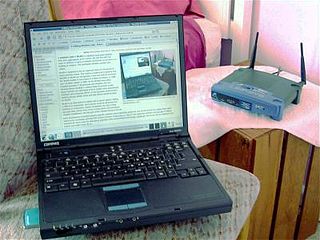FCC MVDDS auctions
MVDDS spectrum was auctioned by the FCC in two separate auctions. The first was FCC auction 53 (1/14/2004 - 1/27/2004) and this auction with 14 qualified bidders lasted 49 rounds over 9 bidding days. 10 bidders won 192 licenses with Gross Bids of $136,936,200 [4] Each allocated license is exclusive in one geographic area.
The second was FCC auction 63 (12/7/2005 - 12/7/2005) and this auction with 3 qualified bidders lasted 3 rounds over 1 bidding day. 32 bidders won the remaining 22 licenses with Gross Bids of $204,000 [4]
MVDDS spectrum (214 licenses) is held by 11 companies, but the largest chunks are owned by three, South.com (an affiliate of Dish Network) with 37 areas, DTV Norwich (an affiliate of Cablevision) with 46 areas, and MDS Operations (an affiliate of MDS America) with 80 areas. [4] [5]
In 2012 Dish Network acquired Cablevision's areas making Dish Network the largest owner of MVDDS spectrum in the US. [6]

Wireless broadband is a telecommunications technology that provides high-speed wireless Internet access or computer networking access over a wide area. The term encompasses both fixed and mobile broadband.

DISH Network L.L.C., often referred to as DISH, an abbreviation for Digital Sky Highway, is an American provider of satellite television and IPTV services and wholly owned subsidiary of EchoStar Corporation.

Low-power broadcasting is broadcasting by a broadcast station at a low transmitter power output to a smaller service area than "full power" stations within the same region. It is often distinguished from "micropower broadcasting" and broadcast translators. LPAM, LPFM and LPTV are in various levels of use across the world, varying widely based on the laws and their enforcement.

MDS America, Inc (MDSA) is a wireless Internet and wireless cable TV technology provider based in Stuart, Florida, US. MDS America was the primary party responsible for the invalidation of Northpoint Technology Inc's patents having to do with extraterrestrial rebroadcast of satellite signals.

WBDT is a television station licensed to Springfield, Ohio, United States, serving the Dayton area as a de facto owned-and-operated station of The CW. It is owned by Vaughan Media, which maintains a local marketing agreement (LMA) with Nexstar Media Group, owner of NBC affiliate WDTN and majority owner of The CW, for the provision of certain services. The two stations share studios on South Dixie Drive in Moraine, Ohio. Through a channel sharing agreement, WBDT, along with Richmond, Indiana–licensed Ion Television O&O WKOI-TV, share WDTN's digital channel from WDTN's transmitter facility on Frytown Road in southwest Dayton.

A spectrum auction is a process whereby a government uses an auction system to sell the rights to transmit signals over specific bands of the electromagnetic spectrum and to assign scarce spectrum resources. Depending on the specific auction format used, a spectrum auction can last from a single day to several months from the opening bid to the final winning bid. With a well-designed auction, resources are allocated efficiently to the parties that value them the most, the government securing revenue in the process. Spectrum auctions are a step toward market-based spectrum management and privatization of public airwaves, and are a way for governments to allocate scarce resources.
WTBY-TV is a religious television station licensed to Jersey City, New Jersey, United States, serving the New York City area as an owned-and-operated station of the Trinity Broadcasting Network (TBN). It is a sister station to Edison, New Jersey–licensed Class A TBN Inspire outlet WDVB-CD. The two stations share studios on East 15th Street in the Union Square neighborhood in Manhattan and transmitter facilities at the Empire State Building.
Cellular frequencies in the United States are allocated by the US Federal Communications Commission. As cellular mobile telephone technology has evolved over time, periodically bands of frequencies are reassigned from other radio services. Companies wishing to provide cellular services in a geographic region compete for the right to license radio spectrum in spectrum auctions. Different cellular companies in the same region may use different levels of cellular technology and different parts of the radio spectrum. In addition to radio frequencies used to connect handsets with cellular base stations, other parts of the radio spectrum are used to interconnect base stations and the wired telephone network. Some frequency bands may be vulnerable to interference by existing services in adjacent frequency bands, such as UHF television broadcasting.
Bandwidth allocation is the process of assigning radio frequencies to different applications. The radio spectrum is a finite resource, which means there is great need for an effective allocation process. In the United States, the Federal Communications Commission or FCC has the responsibility of allocating discrete portions of the spectrum, or bands, to various industries. The FCC did this recently, when it shifted the location of television broadcasting on the spectrum in order to open up more space for mobile data. Different bands of spectrum are able to transmit more data than others, and some bands of the spectrum transmit a clearer signal than others. Bands that are particularly fast or that have long range are of critical importance for companies that intend to operate a business involving wireless communications.
Advanced Wireless Services (AWS) is a wireless telecommunications spectrum band used for mobile voice and data services, video, and messaging. AWS is used in the United States, Argentina, Canada, Colombia, Mexico, Chile, Paraguay, Peru, Ecuador, Trinidad and Tobago, Uruguay and Venezuela. It replaces some of the spectrum formerly allocated to Multipoint Multichannel Distribution Service (MMDS), sometimes referred to as Wireless Cable, that existed from 2150 to 2162 MHz.

Voom HD Networks was a suite of 25 original high-definition television channels owned by AMC Networks. The channels were produced in Crystal Clear Hi-Definition with Dolby Digital 5.1 Surround Sound and were the largest suite of HD channels in the world as part of a 15-year agreement between AMC Networks and Dish Network.
The Educational Broadband Service (EBS) was formerly known as the Instructional Television Fixed Service (ITFS). ITFS was a band of twenty (20) microwave TV channels available to be licensed by the U.S. Federal Communications Commission (FCC) to local credit granting educational institutions. It was designed to serve as a means for educational institutions to deliver live or pre-recorded Instructional television to multiple sites within school districts and to higher education branch campuses. In recognition of the variety and quantity of video materials required to support instruction at numerous grade levels and in a range of subjects, licensees were typically granted a group of four channels. Its low capital and operating costs as compared to broadcast television, technical quality that compared favorably with broadcast television, and its multi-channel per licensees feature made ITFS an extremely cost effective vehicle for the delivery of Educational television materials.
The MVDDS dispute refers to several legal disputes and political controversies that surrounded Federal Communications Commission (FCC) approval of MVDDS terrestrial wireless broadband technology. The controversy arose over the lobbying efforts of Northpoint Technology, a developer of MVDDS, to receive approval and licensing for the technology. The dispute later transformed into several court cases against the FCC and satellite television providers, as well as a patent infringement case against MDS America and MDS International. As a result of the dispute, Northpoint lost the patents.
The United States 700 MHz FCC wireless spectrum auction, officially known as Auction 73, was started by the Federal Communications Commission (FCC) on January 24, 2008 for the rights to operate the 700 MHz radio frequency band in the United States. The details of process were the subject of debate among several telecommunications companies, including Verizon Wireless, AT&T Mobility, as well as the Internet company Google. Much of the debate swirled around the open access requirements set down by the Second Report and Order released by the FCC determining the process and rules for the auction. All bidding was required by law to commence by January 28.
Multichannel television in the United States has been available since at least 1948. The United States is served by multichannel television through cable television systems, direct-broadcast satellite providers, and various other wireline video providers; among the largest television providers in the U.S. are YouTube TV, DirecTV, Altice USA, Charter Communications, Comcast, Dish Network, Verizon Communications, and Cox Communications. The Telecommunications Act of 1996 defines a multichannel video programming distributor (MVPD) as "a person such as, but not limited to, a cable operator, a multichannel multipoint distribution service, a direct broadcast satellite service, or a television receive-only satellite program distributor, who makes available for purchase, by subscribers or customers, multiple channels of video programming", where a channel is defined as a "signaling path provided by a cable television system."
The digital dividend refers to the radio spectrum which is released in the process of digital television transition. When television broadcasters switch from analog TV to digital-only platforms, part of the electromagnetic spectrum that has been used for broadcasting will be freed-up because digital television needs less spectrum than analog television, due to lossy compression. One reason is that new digital video compression technology can transmit numerous digital subchannels using the same amount of spectrum used to transmit one analog TV channel. However, the primary reason is that digital transmissions require much less of a guard band on either side, since they are not nearly as prone to RF interference from adjacent channels. Because of this, there is no longer any need to leave empty channels to protect stations from each other, in turn allowing stations to be repacked into fewer channels, leaving more contiguous spectrum to be allocated for other wireless services.
The 2016 United States wireless spectrum auction, officially known as Auction 1001, allocated approximately 100 MHz of the United States Ultra High Frequency (UHF) spectrum formerly allocated to UHF television in the 600 MHz band. The spectrum auction and subsequent reallocations were authorized by Title VI of the payroll tax cut extension passed by the United States Congress on February 17, 2012.

The C band is a designation by the Institute of Electrical and Electronics Engineers (IEEE) for a portion of the electromagnetic spectrum in the microwave range of frequencies ranging from 4.0 to 8.0 gigahertz (GHz). However, the U.S. Federal Communications Commission C band proceeding and auction, designated 3.7–4.2 GHz as C band. The C band is used for many satellite communications transmissions, some cordless telephones, as well as some radar and weather radar systems.
Citizens Broadband Radio Service (CBRS) is a 150 MHz wide broadcast band of the 3.5 GHz band in the United States. In 2017, the US Federal Communications Commission (FCC) completed a process which began in 2012 to establish rules for commercial use of this band, while reserving parts of the band for the US Federal Government to limit interference with US Navy radar systems and aircraft communications.

DISH Wireless L.L.C., doing business as Boost Mobile, is an American telecommunications company and wholly owned subsidiary of EchoStar Corporation. Boost Mobile is the fourth largest wireless carrier in the United States. Together with its sister brands Gen Mobile and Ting Mobile, it serves 7 million subscribers as of September 30, 2024.









